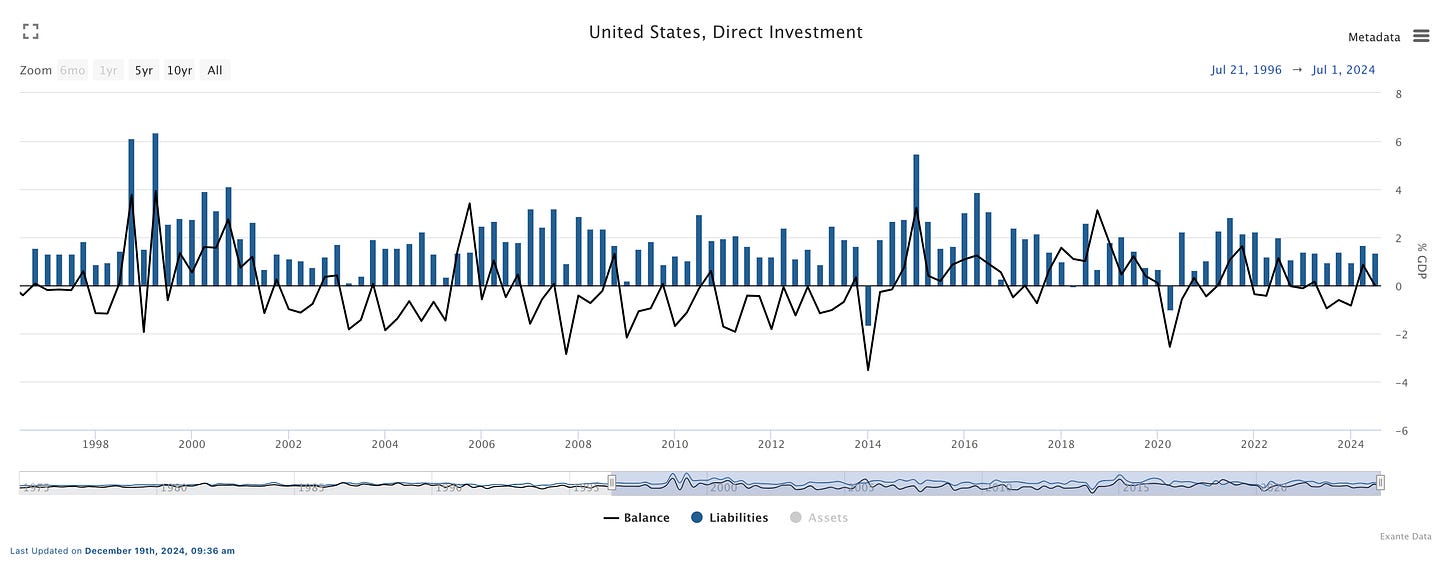I will be delivering the key-note speech at TradeTechFX conference in Miami on Feb 11, and the topic is one of my favorites: The Dollar. Exante Data will be hosting various events in the Miami area on Feb 10-11 (please reach out to kaye.gentle@exantedata.com if you have not yet been invited and see our latest news-letter for more information). The analysis below is forming the basis on the first part of my speech on Tuesday (we will try to cover the second part in a future substack, touching on the macro aspects of the AI topic).
How to analyze the Dollar…
The Dollar is a complex beast. Over the last 30 years, we have generally shifted between the below four variants of dollar analysis:
1/ Some like to focus on the Fed and monetary policy as the key driver.
2/ Some like to focus on growth, and growth differentials, as the crucial determinant
3/ Some like to focus on the Dollar’s reserve currency status as the crucial driving force.
4/ Some like to focus on the trade flows and dollar valuation the most important drivers (and recently, it has become popular to focus on tariff policy as part of this analysis).
Since the Dollar is priced at an extreme level currently, the fourth strand of analysis (dollar valuation) is perhaps more interesting than normal, and I will provide some perspective on that dimension here, while acknowledging that a multi-dimensional approach is almost always needed in relation to financial market forecasting.
Where is the Dollar Relative to History?
The chart below shows a simple chart of the position of the dollar in real (adjusted for inflation) effective (looking at several trading partners) terms:
The dollar is up >30% since it bottomed around 2014, both when looking at the narrow index (mostly G10 countries) and on the broad index (which included emerging markets).
Moreover, the dollar’s level is now matching or surpassing previous peaks, such as the peak observed in the dot.com bubble in the early 2000s or the period with super tight monetary policy during the Volcker years in the early 1980s (and before famous Plaza Accord in 1985).
Is the Dollar Expensive?
If we look at Exante Data’s standard battery of valuation models (which is an aggregation of a dozen models inspired by the academic literature), we get the conclusion that the USD is essentially the most expensive currency among the top 35 most liquid currencies in the world.
And then the question is. Do we trust these model? Is there evidence that dollar valuation is starting to hurt the US economy, beyond the more academic models?
Reality Checks in the Real-Economy
The US trade deficit is indeed historically large in nominal terms, generally exceeding $100bn per month over the last year. However, the composition of the deficit has changed notably. Back in 2005-2008, when there was a lot of focus on trade and current account balances, about half of the deficit was accounted for by commodities (mostly oil). Today, we are in a very different situation. The US is much more energy independent, and is on the verge of becoming a significant energy exporter, as seen in the blue bars starting to flip positive.
In relation to the current account (as % of GDP), however, the overall deficit is not as extreme as in 2005-2008. Into the Global Financial Crisis, the deficit spiked to 6% of GDP driven by extremely high oil prices. Recently, the deficit has been hovering around 3-4%, which is wide, but not quite as wide as 20 years ago, and the IMF is projecting some improvement (along with fiscal consolidation, although it can debated if the IMF forecast for future years is too optimistic
Perhaps more interestingly, we can observe that US exports are performing roughly in line with import growth of key trading partners. This was not the case in 2016-2019, or in the COVID shock. But recently, US exports have been doing ok, relative to the growth of imports in key trading partners.
Moreover, in terms of foreign direct investment, which historically has been sensitive to FX valuation, there is no obvious sign of any negative trend. The FDI balance in recent quarters has been slightly positive, compared to a prolonged negative trend from 2002-2013. And anecdotally, there is plenty of appetite for investment in the US. Or at least that is the message we get from high-profile governmental announcements from Saudi Arabia and Japan recently. You can argue that this has to do with AI and that AI is divorced from currency valuation. But that is part of the point. While the US dollar is expensive versus history, the US remains very competitive in certain key industries, and that is part of the story behind the Dollar’s attractiveness to global investors.
The chart below shows a more forward looking metric of foreign direct investment, created from our own aggregation of M&A deals. And again, it shows more money coming into the US, than coming out.
And finally, we can look at investor sentiment in portfolio flow space too. The chart below shows cross-border flows into the US in ETF and mutual fund flow space on a quarterly basis.
Foreign interest in US equity products has exploded higher over the last 2-3 years, reaching $100bn in Q4 (grey bars). Competitiveness and dollar valuation concerns have certainly not been showing up in cautious investor flows. Rather, 2024 was the exact opposite.
Conclusion
The Dollar looks very expensive on traditional valuation metrics after a sustained appreciation trend since 2014. But external balances are not as deeply in deficit as in the 2005-2008 period because the US’s energy balance has improved dramatically.
Moreover, Dollar valuation issues are not showing up in the way you would traditionally expect (for other trade oriented economies):
Over the last 1-2 years, US exports have actually performed ok (helped by cheap natural gas supplies to US industry), despite a strong dollar.
FDI trends are looking decent; and equity portfolio inflows have been extremely strong up to end-2024.
All told, the US economy is special. And traditional Dollar Valuation metrics should be used with caution, as the US economy is benefitting from ongoing improvement in its energy balance and as the US remains highly competitive its important and arguably dominant the tech sector, somewhat independently from where the USD is trading.
We will have more to say about how this is impacting US growth via CAPEX trends in a separate note. Meanwhile, I hope to see a number of you in Miami in coming days
The content in this piece is partly based on proprietary analysis that Exante Data does for institutional clients as part of its full macro strategy and flow analytics services. The content offered here differs significantly from Exante Data’s full service and is less technical as it aims to provide a more medium-term policy relevant perspective. The opinions and analytics expressed in this piece are those of the author alone and may not be those of Exante Data Inc. or Exante Advisors LLC. The content of this piece and the opinions expressed herein are independent of any work Exante Data Inc. or Exante Advisors LLC does and communicates to its clients.
Exante Advisors, LLC & Exante Data, Inc. Disclaimer
Exante Data delivers proprietary data and innovative analytics to investors globally. The vision of exante data is to improve markets strategy via new technologies. We provide reasoned answers to the most difficult markets questions, before the consensus.
This communication is provided for your informational purposes only. In making any investment decision, you must rely on your own examination of the securities and the terms of the offering. The contents of this communication does not constitute legal, tax, investment or other advice, or a recommendation to purchase or sell any particular security. Exante Advisors, LLC, Exante Data, Inc. and their affiliates (together, "Exante") do not warrant that information provided herein is correct, accurate, timely, error-free, or otherwise reliable. EXANTE HEREBY DISCLAIMS ANY WARRANTIES, EXPRESS OR IMPLIED.












